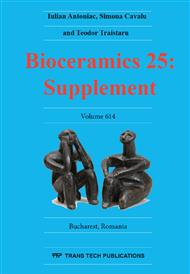[1]
S. Bubenikova, I.C. Stancu, L. Kalinovska, E. Schacht, E. Lippens, H. Declercq, M. Cornelissen, M. Santin, M. Amblard, J. Martinez, Chemoselective cross-linking of alginate with thiol-terminated peptides for tissue engineering applications, Carbohyd. Polym. 88 (2012).
DOI: 10.1016/j.carbpol.2012.01.089
Google Scholar
[2]
D.M. Dragusin, S. Van Vlierberghe, P. Dubruel, M. Dierick, L. Van Hoorebeke, H.A. Declercq, M.M. Cornelissen, I.C. Stancu, Novel gelatin-PHEMA porous scaffolds for tissue engineering applications, Soft Matter. 8 (2012) 9589-9602.
DOI: 10.1039/c2sm25536g
Google Scholar
[3]
I.C. Stancu, Gelatin hydrogels with PAMAM nanostructured surface and high density surface-localized amino groups, React Funct Polym. 70 (2010) 314-324.
DOI: 10.1016/j.reactfunctpolym.2010.02.005
Google Scholar
[4]
I.C. Stancu, A. Lungu, D.M. Dragusin, E. Vasile, C. Petrea, H. Iovu, Porous gelatin-alginate-polyacrylamide scaffolds with interpenetrating network structure: synthesis and characterization, Soft Matter. 11 (2013) 384-393.
DOI: 10.1080/1539445x.2011.642091
Google Scholar
[5]
T. Taguchi, Y. Muraoka, H. Matsuyama, A. Kishida, M. Akashi, Apatite coating on hydrophilic polymer-grafted poly(ethylene) films using an alternate soaking process, Biomaterials. 22 (2000) 53-58.
DOI: 10.1016/s0142-9612(00)00162-9
Google Scholar
[6]
Y.W. Gu, B.Y. Tay, C.S. Lim, M.S. Yong, Biomimetic deposition of apatite coating on surface-modified NiTi alloy, Biomaterials. 26 (2005) 6916-6923.
DOI: 10.1016/j.biomaterials.2005.04.051
Google Scholar
[7]
E. Vasile, A. Serafim, D.M. Dragusin, C. Petrea, H. Iovu, I.C. Stancu, Apatite formation on active nanostructured coating based on functionalized gold nanoparticles, J Nanopart Res. 14 (2012) 1-14.
DOI: 10.1007/s11051-012-0918-1
Google Scholar
[8]
E. Landi, A. Tampieri, G. Celotti, R. Langenati, M. Sandri, S. Sprio, Nucleation of biomimetic apatite in synthetic body fluids: dense and porous scaffold development, Biomaterials. 26 (2005) 2835-2845.
DOI: 10.1016/j.biomaterials.2004.08.010
Google Scholar
[9]
C. You, T. Miyazaki, E. Ishida, M. Ashizuka, C. Ohtsuki, M. Tanihara, Fabrication of poly(vinyl alcohol)–apatite hybrids through biomimetic process, J Eur Ceram Soc. 27 (2007) 1585-1588.
DOI: 10.1016/j.jeurceramsoc.2006.04.055
Google Scholar


